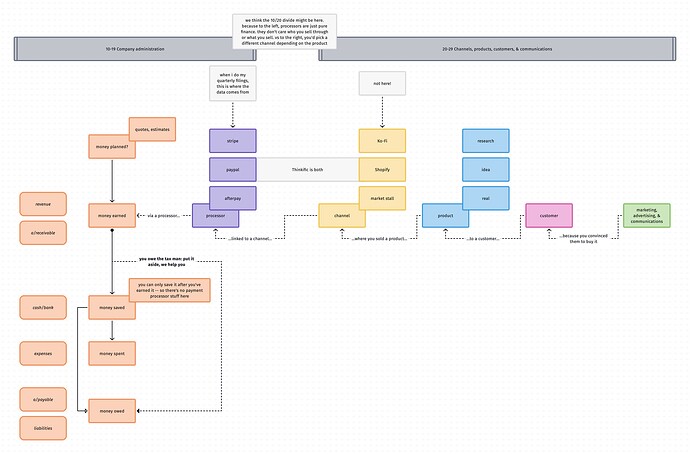Working thoughts, I can see the categories in the 20s being something like:
21 Channels22 Products23 Customers24 Marketing, advertising, & communications
This keeps the flow of things. Per the dotted line through the middle of the diagram:
- You earn money,
- via a payment processor,
- both of which live in
13 Money
- both of which live in
- linked to a
channel, - where you sold a
product, - to a
customer, - because you convinced them to buy it with your
marketing.
What type of business are you?
The shape of 20-29 will change depending on the type of business you run.
- You sell something physical.
- POP Canberra (a local tourist/novelty store).
- Farmer.
- Restaurant.
- You sell a physical service, but the primary product isn’t a physical thing.
- Hairdressing salon.
- Although you might still sell some stuff, e.g. fancy shampoo.
- Gardener.
- Masseuse.
- PT.
- Cleaner.
- Outdoor adventure.
- Driver.
- This isn’t just a service as it’s impossible to do remotely. Being in a physical thing – the car – is integral.
- Hairdressing salon.
- You sell a service.
- Adam the financial advisor.
- Celebrant.
- You could, theoretically (if the law allowed), do this remotely.
- Teacher/tutor.
- Accountant.
- Consultant geologist (Lucy’s dad).
- You provide a digital product.
- When we sold the JD workbook.
- It’s a thing, but it’s not physical: so no stocking, manufacturing, etc.
- Decimal.Business. It’s all digital.
- When we sold the JD workbook.
For some of these, the ‘freelancer pattern’, i.e. expand an area might be more appropriate in some sections, e.g. customers.
TBC! HTH? TTFN.
